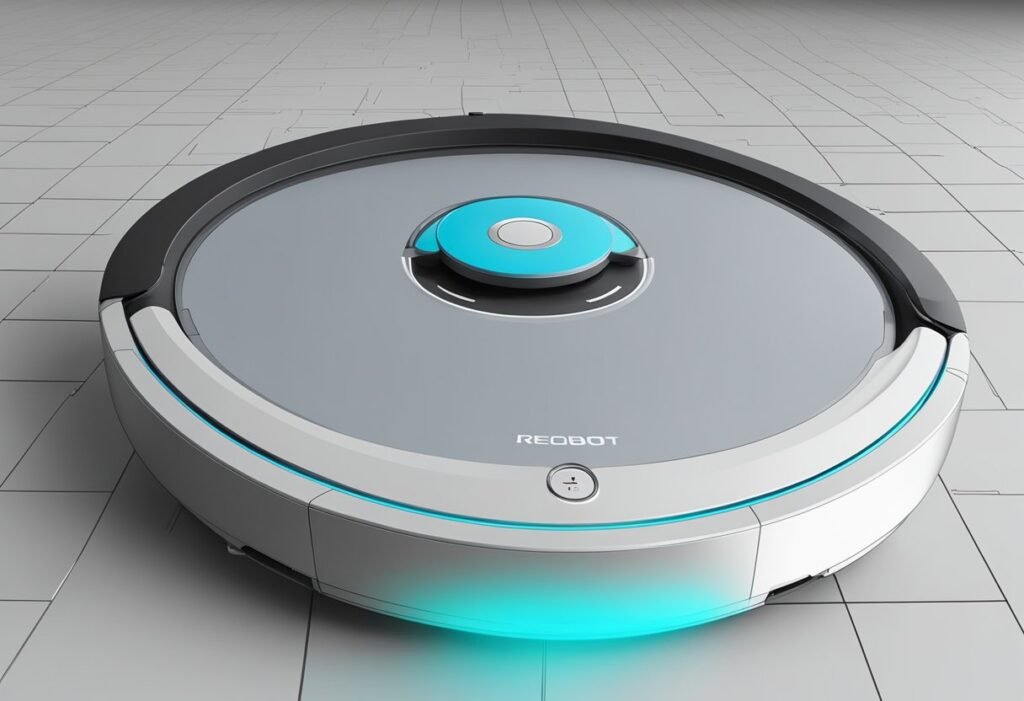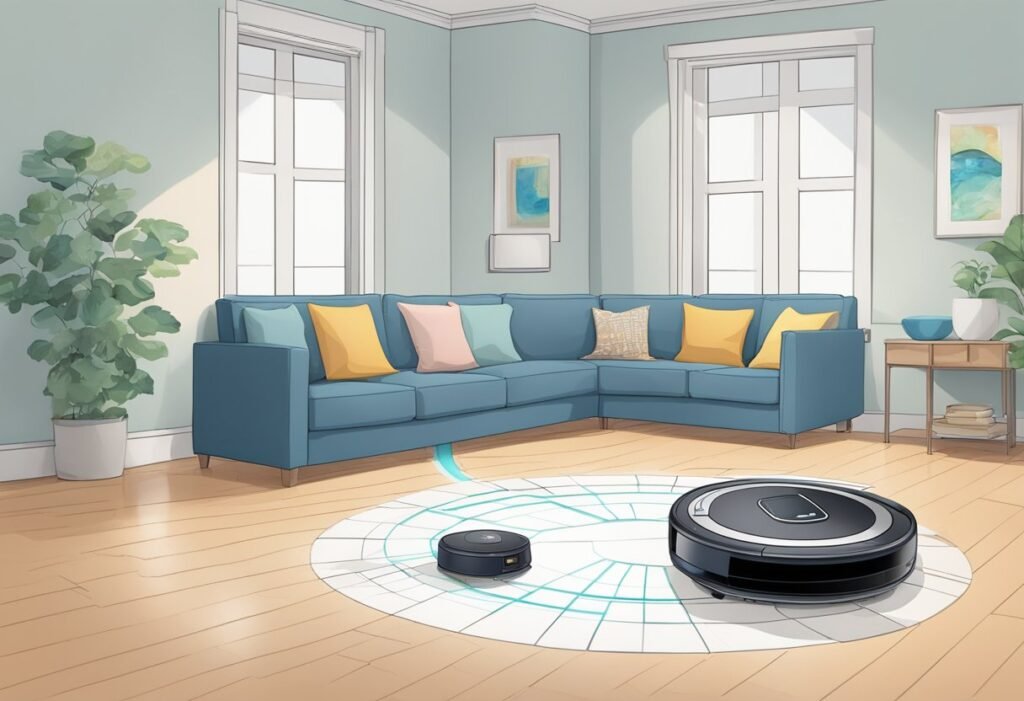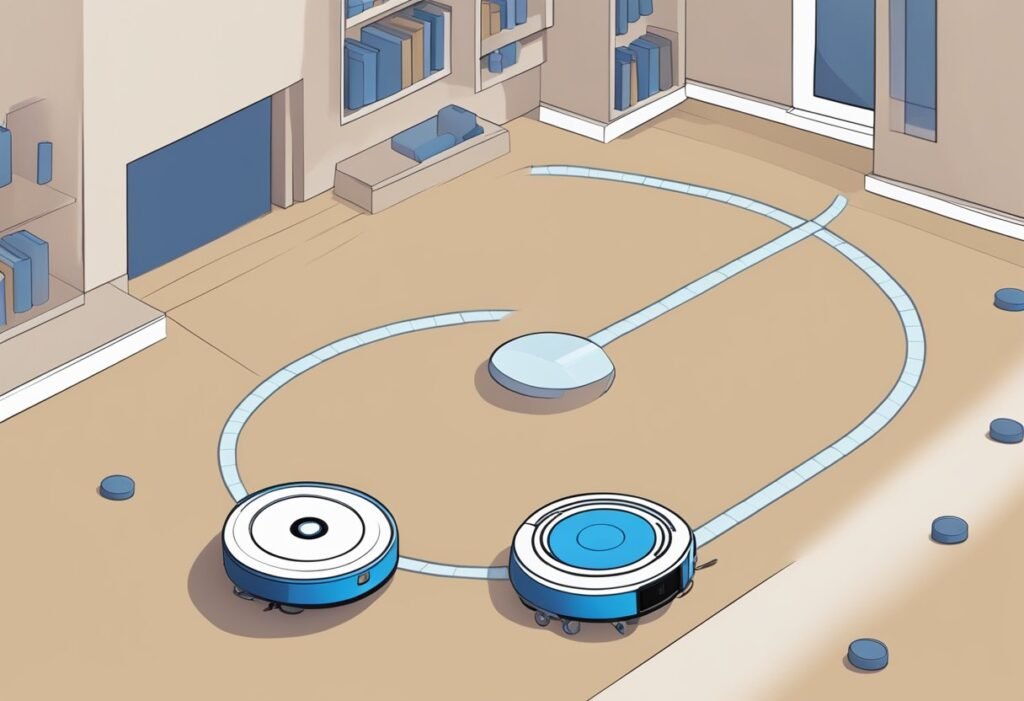With mapping technology, smart robot vacuums create efficient cleaning routes, avoiding obstacles and ensuring thorough coverage. No more random wandering – it’s like a robot with a plan! Without mapping technology, random vacuuming happens, like a game of cleaning roulette. It may get the job done, but don’t be surprised if it misses a spot or takes the scenic route.
Robot vacuum cleaners have revolutionized household cleaning, offering convenience and efficiency. One key feature to consider when choosing a robot vacuum is whether it includes mapping technology. So, it is essential to know robot vacuum mapping vs no mapping.
Robot vacuums with mapping capabilities use advanced sensors and technology to create a map of your home, allowing for more efficient and systematic cleaning.
On the other hand, robot vacuums without mapping technology operate without a predefined map of the cleaning area and may rely on random or pattern-based cleaning algorithms.
The decision between a robot vacuum with mapping and one without depends on your specific cleaning needs and preferences. Robot vacuums with mapping technology are designed to offer more precise and methodical cleaning, potentially resulting in better coverage and reduced cleaning times.
Conversely, robot vacuums without mapping may be more suitable for simpler cleaning tasks and can be a more cost-effective option.

Table of Contents
What Is Robot Vacuum Navigation
When it comes to robot vacuums, one of the most important features is navigation. Navigation is what allows the robot vacuum to move around your home and clean efficiently. There are two types of navigation technologies: mapping and no-mapping.
Mapping Technology Explained
Mapping technology is used in high-end robot vacuums. These vacuums use sensors and cameras to create a map of your home. The map is then used to navigate the robot vacuum around your home, ensuring that it cleans every inch of your floors. Mapping technology is very accurate and efficient, and it can save you a lot of time and effort.
One of the main advantages of mapping technology is that it allows the robot vacuum to clean in straight lines. This means that it can cover more ground in less time, and it can clean more thoroughly. Mapping technology also allows the robot vacuum to avoid obstacles and navigate around furniture, ensuring that it doesn’t get stuck or damaged.
No-Mapping Technology Explained
No-mapping technology is used in lower-end robot vacuums. These vacuums do not use sensors or cameras to create a map of your home. Instead, they rely on random patterns to clean your floors. No-mapping technology is less accurate and efficient than mapping technology, but it is still effective at cleaning your floors.
One of the main disadvantages of no-mapping technology is that it can miss spots. Since the robot vacuum moves in random patterns, it may not clean every inch of your floor. No-mapping technology also tends to take longer to clean your floors, since it doesn’t move in straight lines.
Benefits of Mapping in Robot Vacuums

If you are in the market for a robot vacuum, you may have noticed that some models come with mapping features. While these models may be more expensive, they offer several benefits that can make them worth the investment.
Precision Cleaning Paths
One of the biggest benefits of mapping in robot vacuums is the ability to create precise cleaning paths. With mapping, the robot vacuum can create a detailed map of your home, allowing it to navigate more efficiently and avoid areas it has already cleaned. This means that it can clean your floors more thoroughly and in less time.
Room Selective Cleaning
Another benefit of mapping is the ability to selectively clean certain rooms. With room mapping, you can create virtual boundaries that tell the robot vacuum which rooms to clean and which to avoid. This is particularly useful if you have rooms that are frequently used and need to be cleaned more often than others.
Virtual No-Go Zones
Finally, mapping allows you to create virtual no-go zones. These are areas of your home that you want the robot vacuum to avoid, such as areas with delicate furniture or objects that could be knocked over. With mapping, you can create virtual boundaries around these areas, ensuring that the robot vacuum stays clear of them.
Limitations of Mapping in Robot Vacuums
Robot vacuums with mapping technology have come a long way in terms of navigating and cleaning homes. However, there are still some limitations to their mapping abilities. Here are some of the limitations of mapping in robot vacuums.
Higher Cost
Robot vacuums with mapping technology are generally more expensive than those without. The cost of the technology used in mapping, such as LiDAR, is passed on to the consumer. If you’re on a budget, a robot vacuum without mapping technology could be a more affordable option.
Complex Setup
Setting up a robot vacuum with mapping technology can be more complicated than setting up a non-mapping robot vacuum. Mapping technology requires the robot vacuum to scan the room and create a map of the area, which can take some time. Additionally, some robot vacuums may require you to manually set up virtual barriers to prevent the robot from going into certain areas.
Privacy Concerns
Some people may have concerns about the privacy implications of having a robot vacuum with mapping technology. The robot vacuum is constantly scanning and mapping your home, which could potentially be a privacy concern for some people. However, it’s worth noting that most robot vacuums with mapping technology do not store the maps they create and only use them to navigate your home.
Benefits of Non-Mapping Robot Vacuums

If you’re in the market for a robot vacuum, you may be wondering whether you should go for a model with mapping capabilities or one without. While mapping robot vacuums have their advantages, non-mapping robot vacuums also have their benefits. Here are some advantages of non-mapping robot vacuums:
Simplicity and Ease of Use
One of the biggest advantages of non-mapping robot vacuums is their simplicity. These vacuums don’t have the complex mapping technology that mapping robot vacuums have, which means they’re easier to use. You don’t have to worry about setting up mapping zones or dealing with the quirks of the mapping technology. Instead, you can simply turn on the vacuum and let it do its thing.
Affordability
Another advantage of non-mapping robot vacuums is their affordability. Since they don’t have advanced mapping technology, they tend to be less expensive than their mapping counterparts. This makes them a great option if you’re on a budget or if you don’t want to spend a lot of money on a robot vacuum.
Durability and Maintenance
Non-mapping robot vacuums also tend to be more durable and require less maintenance than mapping robot vacuums. Since they don’t have complex mapping technology, fewer parts can break or malfunction. This means that non-mapping robot vacuums can last longer and require less maintenance over time.
Comparing Performance
When it comes to comparing the performance of robot vacuums with mapping and without mapping features, there are a few key factors to consider.
Cleaning Efficiency
Robot vacuums with mapping features tend to be more efficient in cleaning spaces than those without mapping features. This is because they use sensors and mapping technology to navigate the space and create a cleaning plan, which helps them avoid missing spots or cleaning the same area multiple times. On the other hand, robot vacuums without mapping features may miss spots or clean the same area multiple times, which can lead to less efficient cleaning.
Battery Life and Recharging
Another factor to consider when comparing the performance of robot vacuums with mapping and without mapping features is battery life and recharging. Generally, robot vacuums with mapping features tend to have better battery life and are better at recharging themselves than those without mapping features.
This is because they use their mapping technology to navigate back to their charging dock when they need to recharge, which helps them conserve battery life and stay charged for longer periods.
Overall, while robot vacuums without mapping features may be less expensive, they may also be less efficient in cleaning and have shorter battery life. Robot vacuums with mapping features, on the other hand, maybe more expensive, but they can provide more efficient cleaning and longer battery life.
Ultimately, the choice between a robot vacuum with mapping and without mapping features will depend on your specific needs and budget.
User Experience and Control
When it comes to user experience and control, robot vacuums with mapping features tend to offer a more seamless and convenient experience. Here are some key differences between robot vacuum mapping and non-mapping options in terms of user experience and control:
App Integration and Smart Features
Robot vacuums with mapping features usually come with an app that allows you to control the vacuum from your smartphone. This means you can schedule cleaning sessions, adjust cleaning modes, and even monitor the vacuum’s progress from anywhere. Some models even offer voice control through virtual assistants like Amazon Alexa or Google Assistant.
Non-mapping robot vacuums, on the other hand, may not offer app integration or smart features. This means you may have to manually start and stop the vacuum, and you won’t be able to schedule cleaning sessions or adjust cleaning modes remotely.
Manual Control Options
While app integration and smart features are convenient, some users may prefer more manual control over their robot vacuum. Non-mapping robot vacuums may offer more manual control options, such as physical buttons on the vacuum itself or a remote control.
Mapping robot vacuums may still offer manual control options, but these may be less prominent or accessible compared to the app-based controls. Additionally, some users may find the app-based controls to be less intuitive than physical buttons or a remote control.
Difference Cart: Mapping vs No Mapping Robot Vacuum
Features | Robot Vacuum with Mapping | Robot Vacuum without Mapping |
|---|---|---|
Navigation Precision | Advanced mapping sensors | Random movement algorithms |
Cleaning Efficiency | Systematic room coverage | Randomized cleaning patterns |
Customized Scheduling | Programmable routes | Limited scheduling options |
Obstacle Detection | 3D mapping and sensors | Basic obstacle sensors |
Battery Management | Optimized route planning | Continuous cleaning until idle |
Smart Home Integration | Seamless connectivity | Basic compatibility |
Virtual Boundaries | Define no-go zones | Relies on physical barriers |
Cleaning History Tracking | Detailed cleaning reports | Limited or no tracking |
FAQ
Why is mapping technology important in robot vacuums?
Mapping technology is important in robot vacuums because it helps the robot to navigate around your home more efficiently. Robot vacuums with mapping technology can create a map of your home, which allows them to clean in straight lines and avoid obstacles. This means that they can clean your home more quickly and with less effort.
How do robot vacuums with LiDAR navigation differ from those without?
Robot vacuums with LiDAR navigation use lasers to create a map of your home. This allows them to navigate around your home more accurately and avoid obstacles. Robot vacuums without LiDAR navigation may use other sensors, such as bump sensors or cliff sensors, to navigate around your home. However, these sensors may not be as accurate as LiDAR and may not be able to create a map of your home.
What advantages does SLAM technology provide for robot vacuum navigation?
SLAM (Simultaneous Localization and Mapping) technology allows robot vacuums to create a map of your home and navigate around it at the same time. This means that they can clean your home more efficiently and avoid obstacles more accurately. SLAM technology is particularly useful in larger homes, where it can help the robot to navigate around different rooms and levels.
Can robot vacuums without mapping navigate in straight lines effectively?
Robot vacuums without mapping may not be able to navigate in straight lines as effectively as those with mapping technology. They may rely on other sensors, such as bump sensors or cliff sensors, to navigate around your home. These sensors may not be as accurate as mapping technology and may not be able to create a map of your home. As a result, robot vacuums without mapping may take longer to clean your home and may miss some areas.
How does a robot vacuum’s algorithm affect its cleaning efficiency?
A robot vacuum’s algorithm affects its cleaning efficiency by determining how it navigates around your home. The algorithm controls how the robot moves and how it cleans different areas. A good algorithm can help the robot to navigate around your home more efficiently and clean more effectively. A poorly designed algorithm may cause the robot to miss areas or take longer to clean your home.
What is the typical duration for a robot vacuum to complete mapping a home?
The duration for a robot vacuum to complete mapping a home varies depending on the size of your home and the complexity of the layout. In general, it can take anywhere from a few minutes to a few hours for a robot vacuum to complete mapping a home. Once the robot has created a map of your home, it can use this map to navigate around your home more efficiently and clean more effectively.



